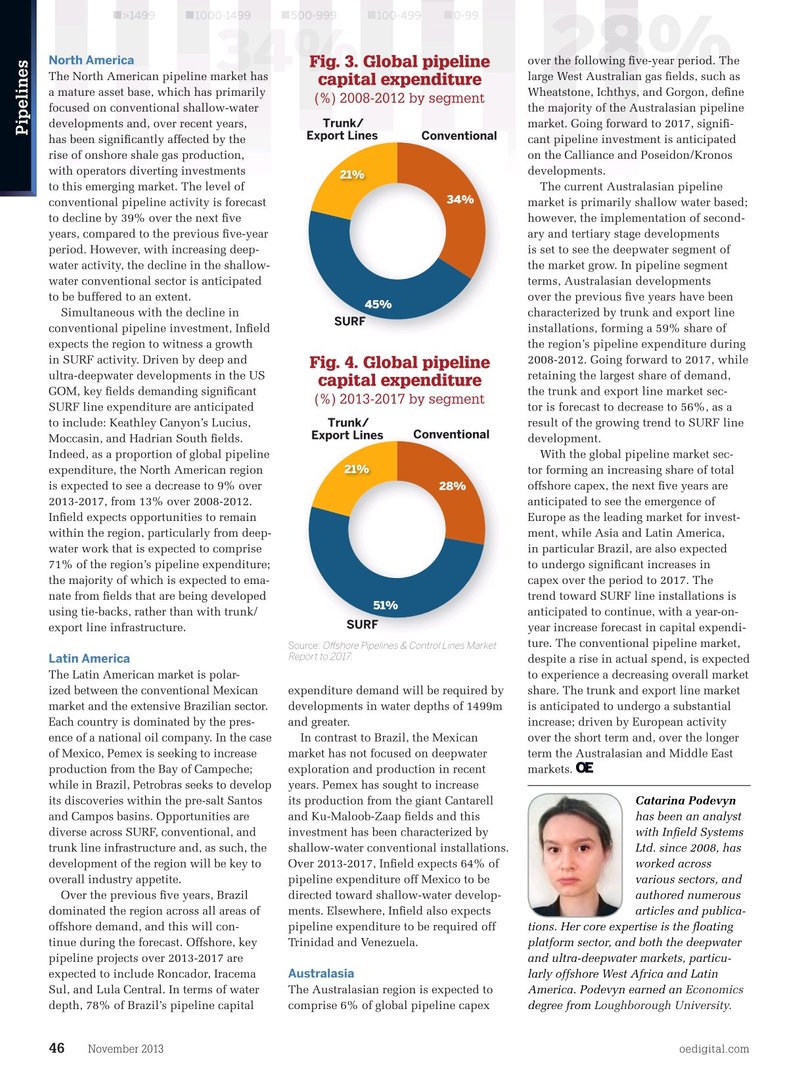
Page 44: of Offshore Engineer Magazine (Nov/Dec 2013)
Read this page in Pdf, Flash or Html5 edition of Nov/Dec 2013 Offshore Engineer Magazine
>1499 1000-1499 500-999 100-499 0-99
North America over the following fve-year period. The
Fig. 3. Global pipeline 28% 34%
The North American pipeline market has large West Australian gas felds, such as capital expenditure a mature asset base, which has primarily Wheatstone, Ichthys, and Gorgon, defne (%) 2008-2012 by segment focused on conventional shallow-water the majority of the Australasian pipeline
Trunk/ developments and, over recent years, market. Going forward to 2017, signif-
Pipelines
Export Lines Export Lines Conventional Conventional has been signifcantly affected by the cant pipeline investment is anticipated rise of onshore shale gas production, on the Calliance and Poseidon/Kronos with operators diverting investments developments. 21% to this emerging market. The level of The current Australasian pipeline 34% conventional pipeline activity is forecast market is primarily shallow water based; to decline by 39% over the next fve however, the implementation of second- years, compared to the previous fve-year ary and tertiary stage developments period. However, with increasing deep- is set to see the deepwater segment of water activity, the decline in the shallow- the market grow. In pipeline segment water conventional sector is anticipated terms, Australasian developments to be buffered to an extent. over the previous fve years have been 45%
Simultaneous with the decline in characterized by trunk and export line
SURF SURF conventional pipeline investment, Infeld installations, forming a 59% share of expects the region to witness a growth the region’s pipeline expenditure during in SURF activity. Driven by deep and 2008-2012. Going forward to 2017, while
Fig. 4. Global pipeline ultra-deepwater developments in the US retaining the largest share of demand, capital expenditure
GOM, key felds demanding signifcant the trunk and export line market sec- (%) 2013-2017 by segment
SURF line expenditure are anticipated tor is forecast to decrease to 56%, as a to include: Keathley Canyon’s Lucius, result of the growing trend to SURF line
Trunk/
Export Lines Conventional Export Lines Conventional
Moccasin, and Hadrian South felds. development.
Indeed, as a proportion of global pipeline With the global pipeline market sec- 21% expenditure, the North American region tor forming an increasing share of total is expected to see a decrease to 9% over offshore capex, the next fve years are 28% 2013-2017, from 13% over 2008-2012. anticipated to see the emergence of
Infeld expects opportunities to remain Europe as the leading market for invest- within the region, particularly from deep- ment, while Asia and Latin America, water work that is expected to comprise in particular Brazil, are also expected 71% of the region’s pipeline expenditure; to undergo signifcant increases in the majority of which is expected to ema- capex over the period to 2017. The nate from felds that are being developed trend toward SURF line installations is 51% using tie-backs, rather than with trunk/ anticipated to continue, with a year-on-
SURF SURF export line infrastructure. year increase forecast in capital expendi- ture. The conventional pipeline market,
Source: Ofshore Pipelines & Control Lines Market .
Report to 2017
Latin America despite a rise in actual spend, is expected
The Latin American market is polar- to experience a decreasing overall market ized between the conventional Mexican expenditure demand will be required by share. The trunk and export line market market and the extensive Brazilian sector. developments in water depths of 1499m is anticipated to undergo a substantial
Each country is dominated by the pres- and greater. increase; driven by European activity ence of a national oil company. In the case In contrast to Brazil, the Mexican over the short term and, over the longer of Mexico, Pemex is seeking to increase market has not focused on deepwater term the Australasian and Middle East production from the Bay of Campeche; exploration and production in recent markets. while in Brazil, Petrobras seeks to develop years. Pemex has sought to increase its discoveries within the pre-salt Santos its production from the giant Cantarell Catarina Podevyn and Campos basins. Opportunities are and Ku-Maloob-Zaap felds and this has been an analyst diverse across SURF, conventional, and investment has been characterized by with Infeld Systems trunk line infrastructure and, as such, the shallow-water conventional installations. Ltd. since 2008, has development of the region will be key to Over 2013-2017, Infeld expects 64% of worked across overall industry appetite. pipeline expenditure off Mexico to be various sectors, and
Over the previous fve years, Brazil directed toward shallow-water develop- authored numerous dominated the region across all areas of ments. Elsewhere, Infeld also expects articles and publica- offshore demand, and this will con- pipeline expenditure to be required off tions. Her core expertise is the foating tinue during the forecast. Offshore, key Trinidad and Venezuela. platform sector, and both the deepwater pipeline projects over 2013-2017 are and ultra-deepwater markets, particu-
Australasia expected to include Roncador, Iracema larly offshore West Africa and Latin
Sul, and Lula Central. In terms of water The Australasian region is expected to America. Podevyn earned an Economics depth, 78% of Brazil’s pipeline capital comprise 6% of global pipeline capex degree from Loughborough University.
November 2013 oedigital.com 46 000_OE1113_Pipelines2.indd 46 10/28/13 1:52 AM

 43
43

 45
45